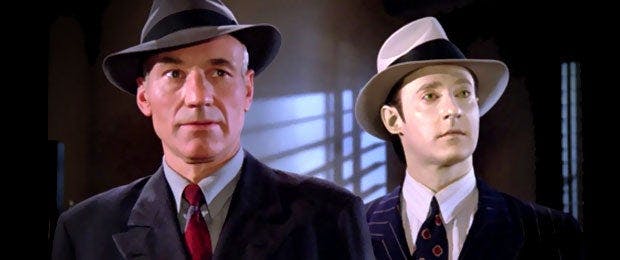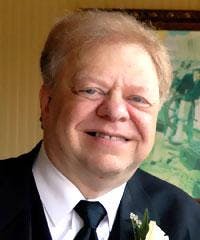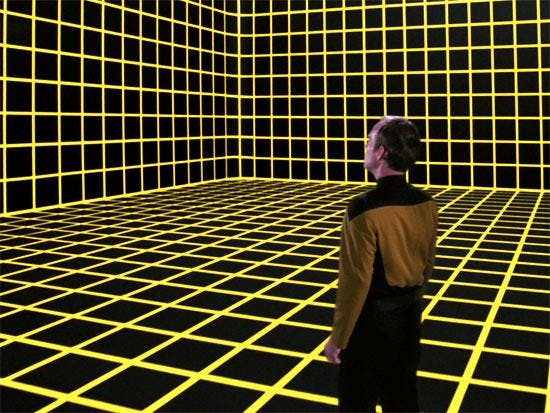Published Mar 11, 2014
Meet The Man Behind The Holodeck, Part 1
Meet The Man Behind The Holodeck, Part 1


Here’s a trivia question for you. Who put the idea of the holodeck into the mind of Star Trek creator, Gene Roddenberry? Here’s another one for you: Who invented the very first LCD projector? And one more: Who interacted in the ultimate fanboy video with DeForest Kelley, George Takei, Walter Koenig, James Doohan and Nichelle Nichols, which included an introduction by Roddenberry? The answers are one and the same -- Gene Dolgoff, whose bio very proudly describes him as “an innovator and entrepreneur in electronics, optics, holography, lenticular, stereoscopic, and other forms of 3-D imaging, and displays, with over 65 granted patents worldwide and 40 patents pending.” Dolgoff, back in 1964, became one of the world's first holographers, for three years teaching a course in optics, lasers and holography at the City College of the City University of New York, and, not surprisingly, authoring the text and curriculum utilized in class.
These days, Dolgoff is Chairman, CEO and CTO of 3-D Vision, a Long Island-based company that conducts research to develop, license and market new products and technologies for the emerging 3D TV/computer field. Yet, for all that, Star Trek fans are most indebted to the man for his contribution to Star Trek, a contribution that’s universally accepted, but was never quite publicly acknowledged by Roddenberry. StarTrek.com caught up with Dolgoff at his office for an informative and science-centric conversation. Below is part one of our two-part interview. Visit StarTrek.com again tomorrow to read part two.
Back in the day, were you a Star Trek fan? We’re assuming your interest in science pre-dated Trek by a wide margin…
DOLGOFF: Exactly. I was into science ever since I was about three years old. I was interested in all kinds of science-fiction and science fact. Once Star Trek came out, I just loved it. I was thrilled about it. I got to be friends with a lot of scientific people, like Isaac Asimov. Isaac and I became friends around 1966, or around there. I got involved in 3D photography starting in 1960 and by the end of 1963, holography was invented, and I was really interested in that. So I called up the researcher who had made the first hologram, Emmett Leith, at the University of Michigan. We became very good friends over the phone and I started learning all about holography. He totally opened up my mind into a new world of physics. I’d been studying physics, but I didn’t understand anything about interference phenomena and holography, and he taught me all about it. So, by 1964, I’d set up my own holography lab in New York, and that was the first holography lab in New York. I was maybe the sixth person in the world doing holograms.

You and Asimov shared a fascination with holography, right?
DOLGOFF: Yes. I went to a talk of Isaac Asimov’s in 1966 and he was fascinated with holography, but he was fascinated by anything scientific. That’s when we got to know each other and we were friends from that point on, until he died. I also got to know other people in science fiction writing. Harlan Ellison became a good friend. I used to lecture at a lot of science fiction conferences and Mensa conferences, and so on. Isaac would sometimes lecture with me. At one conference, which was actually a science fiction convention in 1973, Isaac and Harlan and Arthur C. Clarke and I were all on the bill as lecturers. Somebody made a movie of that, so there’s a scene in this movie where I’m on stage with Isaac and he puts the microphone around my neck like it’s an award. That was just us having fun, joking around. Clarke was midway through writing his book Rendezvous with Rama at the time. He came up to me after the lecture and asked me a lot of questions about my lecture and about holography. He said to me that he’s going to use that in a story, and I said, “Great.” And he wound up adding the holography explanations that I gave him into the next chapter of Rendezvous with Rama.
Take us to how, when and why you met Gene Roddenberry?
DOLGOFF: Well, I’d written a paper. My holography work evolved into understanding a holographic model of the universe and a holographic model of how the human brain works. So I wrote some papers on it and, in 1973, I was asked to deliver the paper at a conference in Czechoslovakia, in Prague. They paid for me to go and I went to deliver this paper on how the brain works. It was fascinating because it was an international conference and I had lot of translators translating. When I’d tell a joke in English, some of the people would laugh. Then the guy who was translating what I said into Russian would translate it, and some more people would laugh. Then the Czechoslovakian translator would translate and some more people would laugh. So it was a strange kind of thing. Anyway, attending this conference was a woman named Melanie Toyofuku, who was partners with a guy named Andrija Puharich, and they were working with the psychic Uri Geller to try to do some experiments that would document Geller’s psychic abilities. I proposed some experiments in my lab, to see if he could influence the interference patterns caused by laser beams. So we did those experiments.
Toyofuku was good friends with Roddenberry, right?
DOLGOFF: And so she started telling him about the experiment we were doing with the holography and the lasers. She came to the lab and saw all these incredible holograms that we’d made, of all different sizes, big and small, three-dimensional images floating in air, and so on. This was 1973. She told Gene all about this and he said he wanted to meet me. So she set up a meeting in New York, at a hotel. Gene and his wife, Majel, were there. I went there to the hotel with Melanie, and I brought a whole bunch of holograms and a laser, and I set it all up in the hotel. And we spent the day looking at the holograms and then going through theory. I explained how it worked and how the interference pattern generates the reconstruction of whatever you made the hologram of. And I introduced the concept that I’d come up with, which was matter holograms. At that point, holograms were used to generate three-dimensional images, but you could pass your hand through the images. So, with matter holograms, I’d realized that matter is made up of interference patterns of energy as well, and so you could actually record a hologram of the structure of matter and then reproduce the matter in the same way. So I then explained to Gene, not only is this the basis to teleportation in the future, but you could make a holographic environment in which people could interact with the objects and the scenes and everything, and create a recreation room, a training room, an area that could be for entertainment. We kind of agreed on the name “holodeck.” I put the holography part in there.
How receptive was Roddenberry to the concept?
DOLGOFF: Oh, he was totally into it. He said, “This is along the lines of what I was trying to think about. I just had no idea how this could be… or could this be?” He said, “I didn’t want to be so ridiculous that it wasn’t right and there wouldn’t be something like this in the future at all.” I said, “No, you’re on the right track completely. This is exactly what will happen,” and I explained, technically, how it would work.
Visit StarTrek.com again tomorrow to read the second half of our exclusive interview with Gene Dolgoff.
